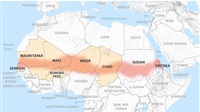Trump faces pressure to reset campaign after Tulsa rally caps gloomy week

Donald Trump flies to Arizona on Tuesday under
pressure to change course in his re-election bid after a dismal week culminated
in the debacle of thousands of empty seats at a campaign rally.
The US president was reportedly angry on Saturday
when his first rally in three months, a defiant gamble amid the coronavirus
pandemic intended as a daunting show of force, backfired with poor attendance
in Tulsa, Oklahoma, a Republican heartland.
In what amounts to a relaunch of a relaunch, Trump
now travels to Arizona, a battleground state, to embrace his most comfortable
signature issue with an event marking the 200th mile of his wall on the
US-Mexico border (most of the construction has in fact replaced existing
barriers).
The president will then speak at a “Students for
Trump” event in Phoenix. Despite soaring cases of coronavirus in Arizona, his
campaign team will be hoping for an enthusiastic turnout to get back on track.
It is not known when Trump will hold his next full rally.
Trump trails his Democratic opponent Joe Biden in
numerous polls, both nationally and in competitive states such as Arizona, in
some cases by double digits. Observers argue that Tulsa was a warning that he
needs to reset, not least because of the health risks of big indoor rallies -
but there appears to be little chance of him heeding advice.
“From what I’ve been told, Trump just insists on
these rallies and he wants more and not fewer compared to 2016 because he’s got
all of the trappings of office and he can fly Air Force One low so people can
be awed and all the rest of it,” said Larry Sabato, director of the Center for
Politics at the University of Virginia.
“Obviously, he
didn’t calculate properly for the pandemic and other factors. He thinks they
can correct it and go on. He wants one every couple of weeks or more
frequently. He didn’t learn a thing. His campaign staff would gladly give them
up, along with the tweets, if they could. But they can’t.”
Trump aides claimed that more than a million people
had requested tickets for the Tulsa rally. The city fire marshal’s office
reported a crowd of just less than 6,200 in the 19,000-seat venue, with few
wearing face masks; eight members of the campaign’s advance team have tested
positive for Covid-19.
The president’’s meandering one-hour-41-minute
speech may come to be seen as exhibit A of a campaign struggling for direction
and at risk of defeat in November. He was criticised for taking a scattergun
approach to Biden, a reflection of how his team’s various and shifting lines of
attack on the former vice-president have failed to gain traction.
The remarks also defended Confederate statues and
indulged racist terms such as “Kung flu” while failing to mention Black Lives
Matter or George Floyd, the African American man killed last month by police in
Minneapolis whose death sparked nationwide protests. Polls suggest Trump’s
unwillingness to strike a chord of national unity alienates voters of colour,
suburban women and independents.
Frank Luntz, a pollster and Republican consultant,
said: “He uses words that make his re-election less likely. Calling his
supporters ‘warriors’ appeals to his supporters, but nobody else. Americans are
not looking for a warrior. They are looking for empathy and understanding and
compassion. If you’re looking for a warrior, you’ve already decided you want
Donald Trump. If you’re looking for social justice, you’ve already decided
you’re voting for Joe Biden.
“There’s only 6% of the American people that are
truly undecided; 94% have made up their minds. That means your words and your
phrases have to be precise. He keeps talking about law and order. The public
wants public safety. He talks about draining the swamp. The public wants a more
efficient, more effective and more accountable government. The words that he’s
using are actually making his case more difficult because they don’t resonate
with that 6%.”
The White House and the Trump campaign, however,
denied media reports that Trump had rebuked his staff or that campaign manager
Brad Parscale was skating on thin ice after overpromising and underdelivering
so spectacularly.
Kayleigh McEnany, the White House press secretary,
insisted on Monday: “The President was very pleased with the rally. I was with
him. And I just have to say these media reports that he was somehow furious on
the plane – there is no grounding in fact to that.”
She added: “A political pundit wrote to him that it
was one of the all-time great speeches they’d ever heard … The speech made his
message so clear and compelling that no one could possibly have missed it. And
it was so great to be out of the swamp and in the country. And those comments
are how the president feels, too.”
Tim Murtaugh, the campaign’s director of
communications, said: “President Trump is eager to keep hitting the campaign
trail and holding more rallies to speak directly to the American people ...
There was a massive media push to crush the Trump rally, and still 12,000
people bravely showed up.
“This is approximately 11,990 more people than
attended the last Biden event. The enthusiasm is with President Trump. As of
Monday morning, more than 11.3 million people had watched the President’s
speech on our digital platforms. There is an enthusiasm gap – it is real and it
is wide.”
But with Trump under fire for boasting at the rally
that he told staff to slow virus testing, Tuesday’s stop in Arizona will not be
straightforward. The state’s positive test rate is at a seven-day average of
more than 20%, the highest in the country.







